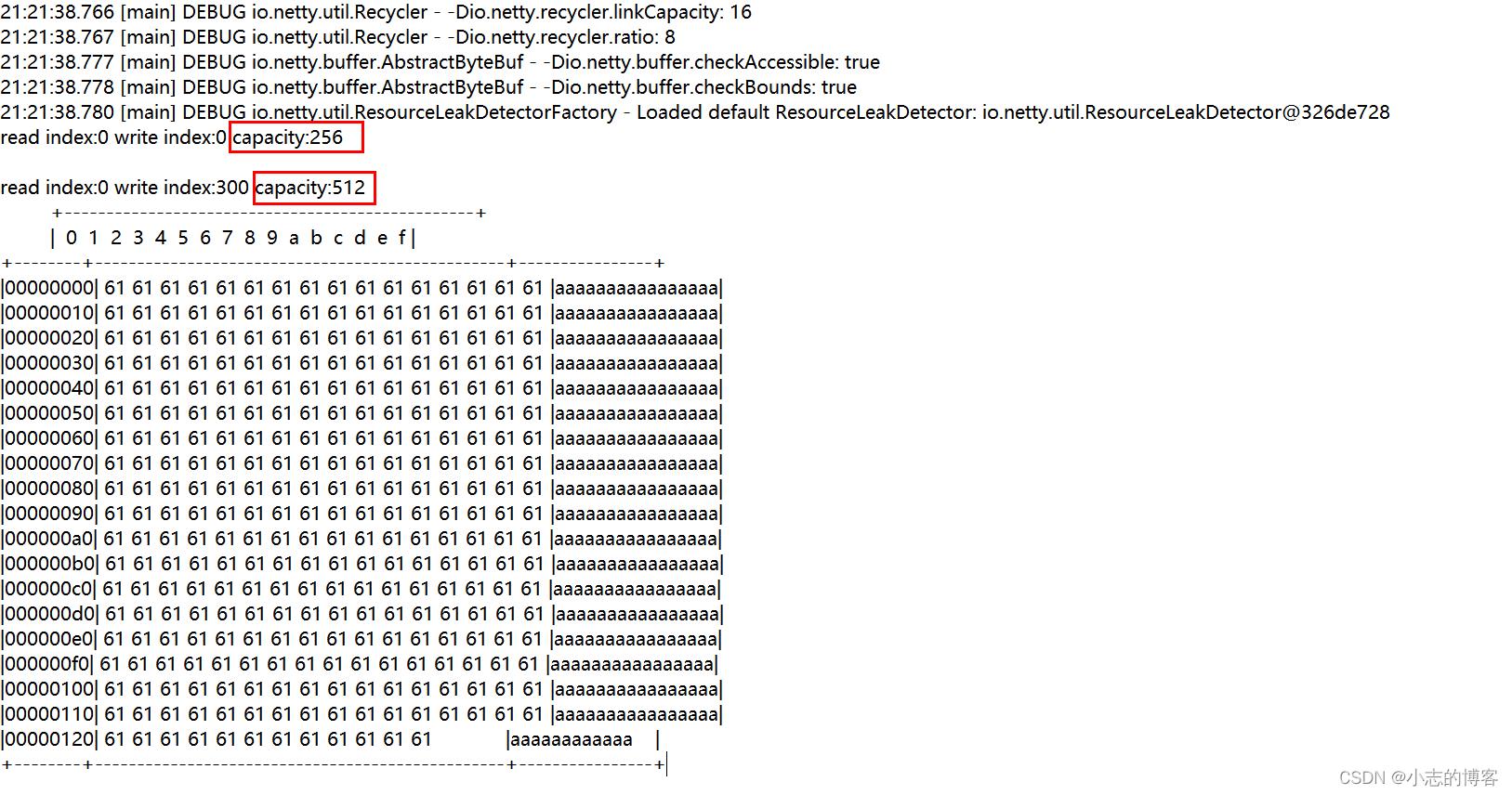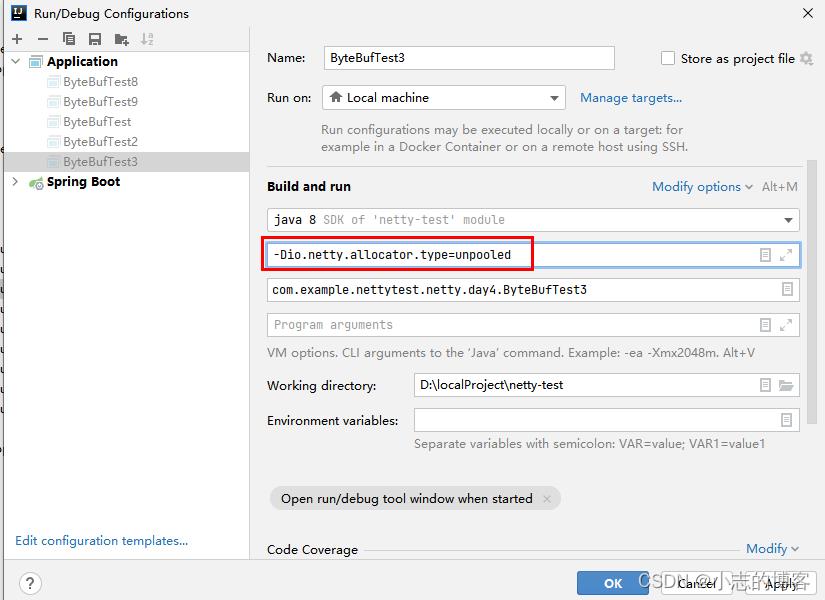Netty ByteBuf入门
Posted
tags:
篇首语:本文由小常识网(cha138.com)小编为大家整理,主要介绍了Netty ByteBuf入门相关的知识,希望对你有一定的参考价值。
参考技术A ByteBuf由一段地址空间,一个read index和一个write index组成。两个index分别记录读写进度,省去了NIO中ByteBuffer手动调用flip和clear的烦恼。通过上图可以很好的理解ByteBuf的数据划分。writer index到capacity之间的部分是空闲区域,可以写入数据;reader index到writer index之间是已经写过还未读取的可读数据;0到reader index是已读过可以释放的区域。
三个index之间的关系是:reader index <= writer index <= capacity
ByteBuf根据其数据存储空间不同有可以分为三种:基于JVM堆内的,基于直接内存的和组合的。
堆内受JVM垃圾收集器的管辖,使用上相对安全一些,不用每次手动释放。弊端是GC是会影响性能的;还有就是内存的拷贝带来的性能损耗(JVM进程到Socket)。
直接内存则不受JVM的管辖,省去了向JVM拷贝数据的麻烦。但是坏处就是别忘了释放内存,否则就会发生内存泄露。相比于堆内存,直接内存的的分配速度也比较慢。
最佳实践:在IO通信的线程中的读写Buffer使用DirectBuffer(省去内存拷贝的成本),在后端业务消息的处理使用HeapBuffer(不用担心内存泄露)。
通过hasArray检查一个ByteBuf heap based还是direct buffer。
ByteBuf提供了两个工具类来创建ByteBuf,分别是支持池化的Pooled和普通的Unpooled。Pooled缓存了ByteBuf的实例,提高性能并且减少内存碎片。它使用Jemalloc来高效的分配内存。
如果在Channel中我们可以通过channel.alloc()来拿到ByteBufAllocator,具体它使用Pool还是Unpool,Directed还是Heap取决于程序的配置。
markReaderIndex和resetReaderIndex是一个成对的操作。markReaderIndex可以打一个标记,调用resetReaderIndex可以把readerIndex重置到原来打标记的位置。
discardReadByte可以把读过的空间释放,这时buffer的readerIndex置为0,可写空间和writerIndex也会相应的改变。discardReadBytes在内存紧张的时候使用用,但是调用该方法会伴随buffer的内存整理的。这是一个expensive的操作。
clear是把readerIndex和writerIndex重置到0。但是,它不会进行内存整理,新写入的内容会覆盖掉原有的内容。
派生操作会产生一个新的ByteBuf实例。这里的新指得是ByteBuf的引用是新的所有的index也是新的。但是它们共用着一套底层存储。派生函数:
如果想要复制一个 全新 的ByteBuffer请使用copy,这会完全的复制一个新的ByteBuf出来。
引用计数记录了当前ByteBuf被引用的次数。新建一个ByteBuf它的refCnt是1,当refCnt == 0时,这个ByteBuf即可被回收。
引用技术主要用于内存泄露的判断,Netty提供了内存泄露检测工具。通过使用参数 -Dio.netty.leakDetectionLevel=$level 可以配置检测级别:
很多时候需要从ByteBuf中查找特定的字符,比如LineBasedFrameDecoder需要在ByteBuf中查找'\r\n'。ByteBuf提供了简单的indexOf这样的函数。同时也可以使用ByteProcesser来查找。
以下 gist 提供了一些example。
Netty入门——ByteBuf
目录
一、ByteBuf的概述
- ByteBuf是对字节数据的封装。
二、ByteBuf的创建
2.1、创建一个带有初始容量的ByteBuf代码示例
-
代码示例
import io.netty.buffer.ByteBuf; import io.netty.buffer.ByteBufAllocator; import static io.netty.buffer.ByteBufUtil.appendPrettyHexDump; import static io.netty.util.internal.StringUtil.NEWLINE; /** * @description: ByteBuf(创建) * @author: xz */ public class ByteBufTest public static void main(String[] args) //createByteBuf1(); /** * 创建了一个初始容量是 10 的ByteBuf * */ public static void createByteBuf1() //创建了一个默认的 ByteBuf(池化基于直接内存的 ByteBuf),初始容量是 10 ByteBuf buf = ByteBufAllocator.DEFAULT.buffer(10); System.out.println("查看设置的ByteBuf初始容量:"+buf); /** * 输出ByteBuf的工具类 * */ public static void log(ByteBuf buffer) int length = buffer.readableBytes(); int rows = length / 16 + (length % 15 == 0 ? 0 : 1) + 4; StringBuilder buf = new StringBuilder(rows * 80 * 2) .append("read index:").append(buffer.readerIndex()) .append(" write index:").append(buffer.writerIndex()) .append(" capacity:").append(buffer.capacity()) .append(NEWLINE); appendPrettyHexDump(buf, buffer); System.out.println(buf.toString()); -
输出结果

2.2、查看ByteBuf最大容量的代码示例
-
代码示例
import io.netty.buffer.ByteBuf; import io.netty.buffer.ByteBufAllocator; import static io.netty.buffer.ByteBufUtil.appendPrettyHexDump; import static io.netty.util.internal.StringUtil.NEWLINE; /** * @description: ByteBuf(创建) * @author: xz */ public class ByteBufTest public static void main(String[] args) createByteBuf2(); /** * 查看ByteBuf最大容量 * */ public static void createByteBuf2() //创建了一个默认的 ByteBuf(池化基于直接内存的 ByteBuf) ByteBuf buf = ByteBufAllocator.DEFAULT.buffer(); //查看ByteBuf最大容量 System.out.println("ByteBuf最大容量:"+buf.maxCapacity()); /** * 输出ByteBuf的工具类 * */ public static void log(ByteBuf buffer) int length = buffer.readableBytes(); int rows = length / 16 + (length % 15 == 0 ? 0 : 1) + 4; StringBuilder buf = new StringBuilder(rows * 80 * 2) .append("read index:").append(buffer.readerIndex()) .append(" write index:").append(buffer.writerIndex()) .append(" capacity:").append(buffer.capacity()) .append(NEWLINE); appendPrettyHexDump(buf, buffer); System.out.println(buf.toString()); -
输出结果

2.3、查看ByteBuf最大容量及扩容后最大容量的代码示例
-
代码示例
import io.netty.buffer.ByteBuf; import io.netty.buffer.ByteBufAllocator; import static io.netty.buffer.ByteBufUtil.appendPrettyHexDump; import static io.netty.util.internal.StringUtil.NEWLINE; /** * @description: ByteBuf(创建) * @author: xz */ public class ByteBufTest public static void main(String[] args) createByteBuf3(); /** * 查看ByteBuf最大容量及扩容后的最大容量 * */ public static void createByteBuf3() //1、创建了一个默认的 ByteBuf(池化基于直接内存的 ByteBuf),最大容量256 ByteBuf buf = ByteBufAllocator.DEFAULT.buffer(); //调用输出ByteBuf的工具类 log(buf); //2、创建长度为300的字符串写入ByteBuf,查看扩容后的最大容量 StringBuilder sb = new StringBuilder(); for (int i = 0; i < 300; i++) sb.append("a"); buf.writeBytes(sb.toString().getBytes()); //调用输出ByteBuf的工具类 log(buf); /** * 输出ByteBuf的工具类 * */ public static void log(ByteBuf buffer) int length = buffer.readableBytes(); int rows = length / 16 + (length % 15 == 0 ? 0 : 1) + 4; StringBuilder buf = new StringBuilder(rows * 80 * 2) .append("read index:").append(buffer.readerIndex()) .append(" write index:").append(buffer.writerIndex()) .append(" capacity:").append(buffer.capacity()) .append(NEWLINE); appendPrettyHexDump(buf, buffer); System.out.println(buf.toString()); -
输出结果

三、ByteBuf (直接内存 vs 堆内存)
3.1、创建池化基于堆的ByteBuf 代码示例
-
代码示例
import io.netty.buffer.ByteBuf; import io.netty.buffer.ByteBufAllocator; import static io.netty.buffer.ByteBufUtil.appendPrettyHexDump; import static io.netty.util.internal.StringUtil.NEWLINE; /** * @description: ByteBuf (直接内存 vs 堆内存) * @author: xz */ public class ByteBufTest2 public static void main(String[] args) //创建了一个默认的 ByteBuf(创建池化基于堆的 ByteBuf),初始容量是 10 ByteBuf buf1 = ByteBufAllocator.DEFAULT.heapBuffer(10); //通过输出类信息PooledUnsafeHeapByteBuf可知,采用的是池化基于堆内存 System.out.println(buf1.getClass());//输出class io.netty.buffer.PooledUnsafeHeapByteBuf //输出容量 log(buf1); /** * 输出ByteBuf的工具类 * */ public static void log(ByteBuf buffer) int length = buffer.readableBytes(); int rows = length / 16 + (length % 15 == 0 ? 0 : 1) + 4; StringBuilder buf = new StringBuilder(rows * 80 * 2) .append("read index:").append(buffer.readerIndex()) .append(" write index:").append(buffer.writerIndex()) .append(" capacity:").append(buffer.capacity()) .append(NEWLINE); appendPrettyHexDump(buf, buffer); System.out.println(buf.toString()); -
输出结果

3.2、创建池化基于直接内存的ByteBuf 代码示例
-
代码示例
import io.netty.buffer.ByteBuf; import io.netty.buffer.ByteBufAllocator; import static io.netty.buffer.ByteBufUtil.appendPrettyHexDump; import static io.netty.util.internal.StringUtil.NEWLINE; /** * @description: ByteBuf (直接内存 vs 堆内存) * @author: xz */ public class ByteBufTest2 public static void main(String[] args) //创建了一个默认的 ByteBuf(创建池化基于直接内存的 ByteBuf),初始容量是 10 ByteBuf buf2 = ByteBufAllocator.DEFAULT.directBuffer(10); //通过输出类信息PooledUnsafeDirectByteBuf可知,采用的是池化基于直接内存 System.out.println(buf2.getClass());//输出class io.netty.buffer.PooledUnsafeDirectByteBuf //输出容量 log(buf2); /** * 输出ByteBuf的工具类 * */ public static void log(ByteBuf buffer) int length = buffer.readableBytes(); int rows = length / 16 + (length % 15 == 0 ? 0 : 1) + 4; StringBuilder buf = new StringBuilder(rows * 80 * 2) .append("read index:").append(buffer.readerIndex()) .append(" write index:").append(buffer.writerIndex()) .append(" capacity:").append(buffer.capacity()) .append(NEWLINE); appendPrettyHexDump(buf, buffer); System.out.println(buf.toString()); -
输出结果

四、ByteBuf (池化 vs 非池化)
4.1、默认采用的是池化基于直接内存的 代码示例
-
代码示例
import io.netty.buffer.ByteBuf; import io.netty.buffer.ByteBufAllocator; /** * @description: ByteBuf (池化 vs 非池化) * @author: xz */ public class ByteBufTest3 public static void main(String[] args) getPooledByteBuf(); /** * 默认采用的是池化基于直接内存 * */ public static void getPooledByteBuf() //创建了一个默认的 ByteBuf(创建池化基于直接内存的 ByteBuf) ByteBuf buf1 = ByteBufAllocator.DEFAULT.buffer(); //通过输出类信息PooledUnsafeDirectByteBuf可知,采用的是池化基于直接内存 System.out.println(buf1.getClass());//输出class io.netty.buffer.PooledUnsafeDirectByteBuf -
输出结果

4.1、设置vm参数采用非池化基于直接内存的 代码示例
-
代码示例
import io.netty.buffer.ByteBuf; import io.netty.buffer.ByteBufAllocator; /** * @description: ByteBuf (池化 vs 非池化) * @author: xz */ public class ByteBufTest3 public static void main(String[] args) getUnPooledByteBuf(); /** * 通过设置vm参数 -Dio.netty.allocator.type=unpooled之后, * 采用的是非池化基于直接内存 * */ public static void getUnPooledByteBuf() //创建了一个默认的 ByteBuf(创建非池化基于直接内存的 ByteBuf) ByteBuf buf1 = ByteBufAllocator.DEFAULT.buffer(); //通过输出类信息UnpooledByteBufAllocator可知,采用的是非池化基于直接内存 System.out.println(buf1.getClass());//输出class io.netty.buffer.UnpooledByteBufAllocator$InstrumentedUnpooledUnsafeNoCleanerDirectByteBuf -
通过设置vm参数 -Dio.netty.allocator.type=unpooled之后,采用非池化基于直接内存。

-
输出结果

五、ByteBuf 组成
- ByteBuf 由四部分组成,最开始读写指针都在 0 位置。

六、ByteBuf 写入
6.1、ByteBuf 写入方法
-
ByteBuf 写入方法列表,省略一些不重要的方法
方法签名 含义 备注 writeBoolean(boolean value) 写入 boolean 值 用一字节 01|00 代表 true|false writeByte(int value) 写入 byte 值 writeShort(int value) 写入 short 值 writeInt(int value) 写入 int 值 Big Endian,即 0x250,写入后 00 00 02 50,先写高位在写低位 writeIntLE(int value) 写入 int 值 Little Endian,即 0x250,写入后 50 02 00 00,先写低位在写高位 writeLong(long value) 写入 long 值 writeChar(int value) 写入 char 值 writeFloat(float value) 写入 float 值 writeDouble(double value) 写入 double 值 writeBytes(ByteBuf src) 写入 netty 的 ByteBuf writeBytes(byte[] src) 写入 byte[] writeBytes(ByteBuffer src) 写入 nio 的 ByteBuffer int writeCharSequence(CharSequence sequence, Charset charset) 写入字符串
6.2、ByteBuf 写入的 代码示例
-
代码示例
import io.netty.buffer.ByteBuf; import io.netty.buffer.ByteBufAllocator; import static io.netty.buffer.ByteBufUtil.appendPrettyHexDump; import static io.netty.util.internal.StringUtil.NEWLINE; /** * @description: ByteBuf (写入) * @author: xz */ public class ByteBufTest4 public static void main(String[] args) getWriteBytes(); public static void getWriteBytes() //创建了一个默认的 ByteBuf(池化基于直接内存的 ByteBuf),初始容量是 10 ByteBuf buf1 = ByteBufAllocator.DEFAULT.buffer(10); //1、先写入 4 个字节 buf1.writeBytes(new byte[]1, 2, 3, 4); log(buf1); //2、再写入一个 int 整数,也是 4 个字节 buf1.writeInt(5); log(buf1); /** * 输出ByteBuf的工具类 * */ public static void log(ByteBuf buffer) int length = buffer.readableBytes(); int rows 以上是关于Netty ByteBuf入门的主要内容,如果未能解决你的问题,请参考以下文章